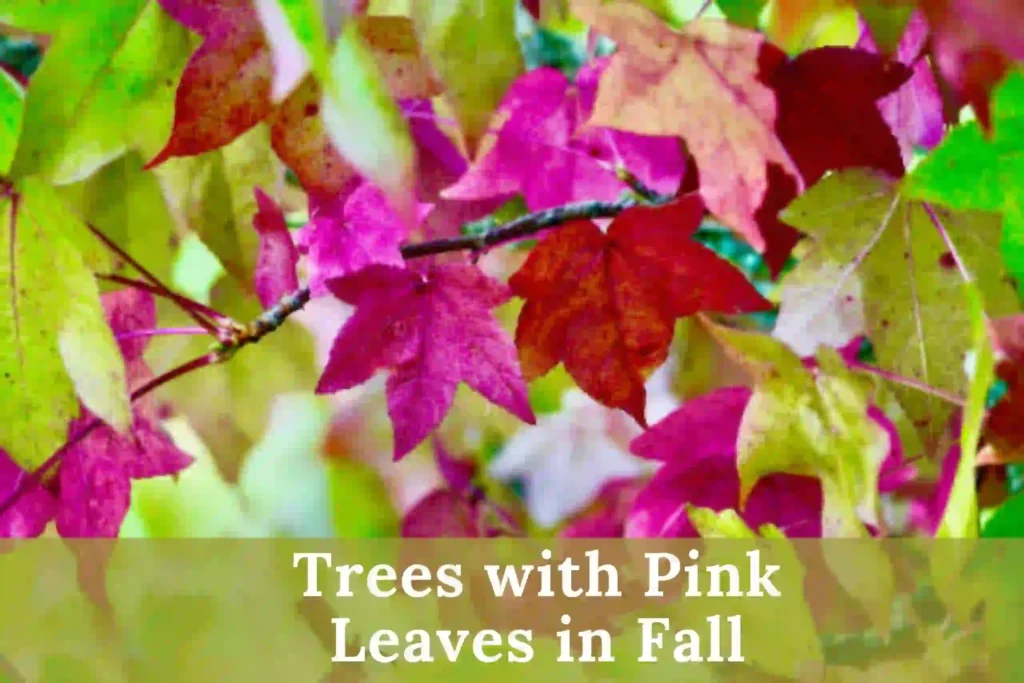When fall rolls around, the landscape is typically dominated by shades of red, orange, and the usual autumn foliage. However, for a more unique color twist, why not consider trees with pink leaves?
These trees stand out by offering an unexpected visual treat, with leaves in blushing pink, neon magenta, and even deeper hues. Imagine how stunning your yard could look with such a striking contrast against the typical fall colors, as these pink-leaved trees bring a fresh and vibrant look to your landscape.
The way they glow when backlit by the sun creates a stunning visual effect, adding visual interest and a pop of color that will make your yard the talk of the neighborhood.
If you’re looking to spice up your yard this fall, explore the many options of trees with pink leaves. From rosy foliage that seems to light up the space, to their ability to add a surprising burst of color to conventional hues, these trees bring something new to the table.
With over 10 options to choose from, you can explore a variety of shades and styles to find the perfect match for your space. Whether they are planted as a central feature or mixed into your existing landscape, these trees will create a memorable atmosphere, offering a perfect balance of punch of color and natural beauty.
1. Pink Flair Cherry (Prunus sargentii ‘Pink Flair’)

The Pink Flair Cherry is one of the strongest pink-leafed trees that adds a touch of elegance to any landscape. In spring, its foliage bursts into a striking bubblegum pink that gradually fades to green during the summer.
As fall arrives, the tree’s leaves turn back to a bold, magenta-pink, creating a beautiful contrast before dropping in the colder months. The small flowering cherry tree grows to a height of 15-25 feet and has an oval shape that transitions into a vase shape as it matures. Its compact size and vibrant colors make it ideal for those looking to add an eye-catching feature to their garden.
For the brightest color, plant the Pink Flair Cherry in full sun where it can thrive. This tree is not only visually appealing but also sturdy, offering year-round interest with its striking color changes and compact form. Whether you choose to plant it as a focal point or as part of a larger landscape design, the Pink Flair Cherry will stand out and offer a unique touch to your outdoor space.
2. Prunus x ‘Pink Snow Showers’
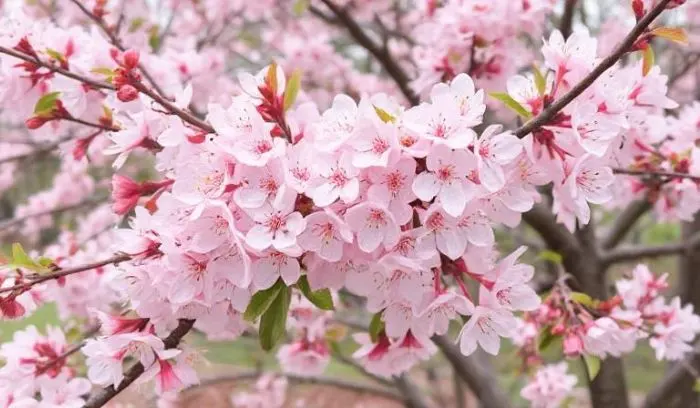
Prunus x ‘Pink Snow Showers’ is a beautiful hybrid flowering cherry known for its striking appearance. In the early stages, its light pink leaves with white variegation create a soft, attractive display.
As the seasons change, the leaves transition to green in summer and then shift back to pinkish-red hues in autumn. One of the standout features of this tree is its fragrant shell pink flowers that bloom in spring, offering an added bonus to the landscape.
The tree remains compact, typically growing to about 15 feet in both height and width, making it an ideal choice for smaller gardens or landscapes.
For the best growth, this tree needs to be planted in full sun and well-drained soil. It’s a resilient tree that reaches its maturity over time, offering beauty and fragrance through the changing seasons. The compact tree form ensures it can fit well in tight spaces while providing plenty of visual interest throughout the year.
3. Red Maple (Acer rubrum)
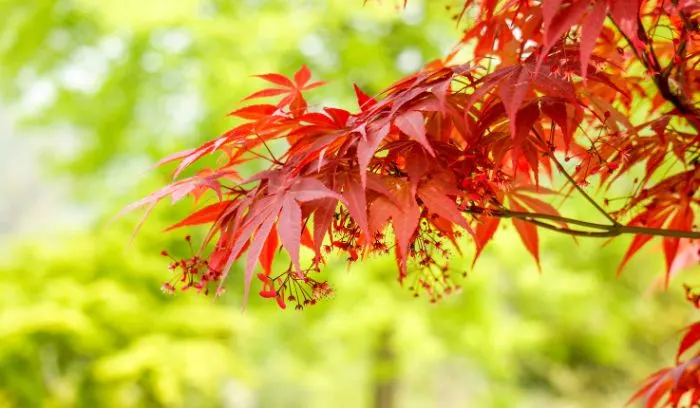
The Red Maple is well-known for its stunning flaming fall color, transitioning from brilliant scarlet to orange. Before the leaves fully change, the five-lobed leaves briefly take on beautiful shades of vibrant pink, adding extra charm to the tree.
This large shade tree creates a kaleidoscope of autumn hues, making it a spectacular choice for gardens or yards. With a 40-60 foot spread, it provides ample shade while contributing a vibrant color palette to your landscape.
For the best growth, plant the Red Maple in full sun to partial shade and be sure to irrigate it regularly. With proper care, this tree will flourish, providing beauty and shade year-round. Its colorful leaves in fall are just one of the many reasons why it remains a favorite among landscapers and gardeners alike.
4. Trident Maple (Acer buergerianum)
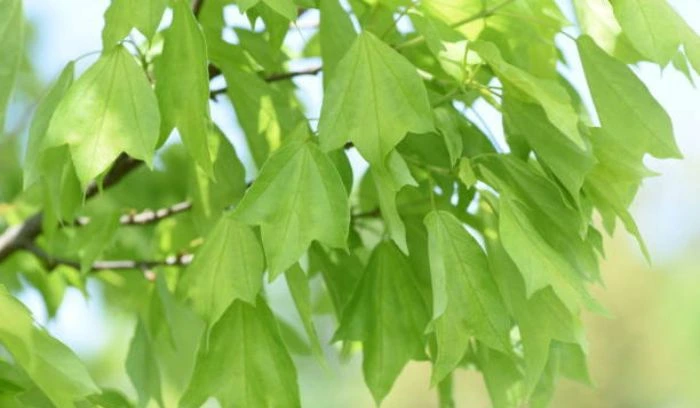
The Trident Maple is a small understory tree known for its impressive display of colors in fall. Its three-pronged leaves transition beautifully from green to vibrant shades of pink, red, orange, and yellow before dropping. This tree reaches a height of around 20-30 feet, making it perfect for smaller yards that need a tree that won’t take up too much space. The Trident Maple thrives in partial shade and requires evenly moist soil to grow properly.
In addition to its beautiful symphony of fall colors, the Trident Maple is also admired for its versatility and size. It can grow tall and wide, but it remains ideal for those looking to add a colorful accent to their landscape without overwhelming the space.
Whether you’re planning to enhance the beauty of a compact yard or just want a tree that adds character, this tree is a wonderful choice. Its colors and overall structure make it a great option for anyone seeking a unique and manageable tree for their garden.
5. Paperbark Maple (Acer griseum)

The Paperbark Maple is a tree that truly stands out in the landscape, especially with its exfoliating coppery bark. As fall approaches, this tree offers plenty of fall interest with its beautiful tri-lobed leaves that turn a brilliant crimson and pink before falling.
Even after the leaves have fallen, the curled leaves remain attached to the tree, adding texture and visual interest throughout the winter. This unique feature makes the tree an attractive year-round presence in the garden.
Growing between 20-30 feet in height, the Paperbark Maple thrives in both full sun and partial shade, making it a versatile choice for various garden conditions.
The combination of vibrant autumn colors, the texture of its curled leaves, and the distinct look of its bark makes it an ideal tree for those looking to add a touch of elegance and charm to their landscape.
6. Amur Maple (Acer ginnala)

The Amur Maple is a small tree that’s perfect for adding fall color to your yard. Native to northeastern Asia, this tree’s foliage changes from green to stunning shades of bright red, orange, and hot pink before dropping in the autumn.
The transformation of the leaves creates a vibrant display that makes it a standout in any garden. When the leaves fall, the tree reveals its striated bark, which adds an extra layer of texture to its appearance. This tree grows to 15-20 feet in height, with a shape that can be either oval or spreading depending on how it’s pruned.
If you’re looking to plant this tree, it thrives in full sun to partial shade and needs only occasional irrigation to keep it healthy. The Amur Maple is an excellent choice for those seeking a compact, colorful tree that doesn’t take up too much space while still offering a beautiful display of fall color and texture.
7. Flowering Dogwood (Cornus florida)

The Flowering Dogwood is a beloved tree, known for its showy spring blooms and red fall berries that add color to your garden year-round. Its oval green leaves transform beautifully in autumn, changing to dusky shades of deep pink and purple.
These color changes, along with its striking flowers and berries, bring multi-season interest to the landscape. As a small understory tree, the Flowering Dogwood grows between 15-30 feet in height, making it ideal for smaller yards or spaces where you need a tree that doesn’t dominate.
It thrives in partial shade and prefers evenly moist, acidic soil for the best growth. These ideal conditions help it flourish, adding both beauty and structure to any garden. Whether planted as a stand-alone feature or mixed with other shrubs, the Flowering Dogwood is a versatile tree that brings seasonal color and texture to your landscape.
8. Chinese Pistache (Pistacia chinensis)
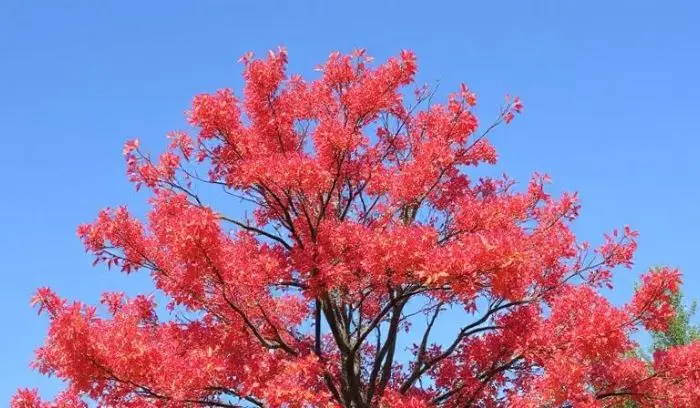
The Chinese Pistache is a stunning medium-sized tree that adds vibrant fall color to any landscape. In the autumn, its pinnately compound leaves change from green to bright fiery shades of orange, red, and hot pink, creating a beautiful spectacle.
As the leaves begin shedding, the tree’s branches are left with an impressive bare structure that stands tall in any garden. Reaching a mature height of 30-50 feet, the Chinese Pistache grows in an upright oval shape, making it an ideal choice for various yards.
It thrives in full sun and requires moderate irrigation to keep the soil evenly moist. With its exceptional color changes and adaptability, it’s a perfect tree for creating interest throughout the seasons.
9. Sourwood (Oxydendrum arboreum)
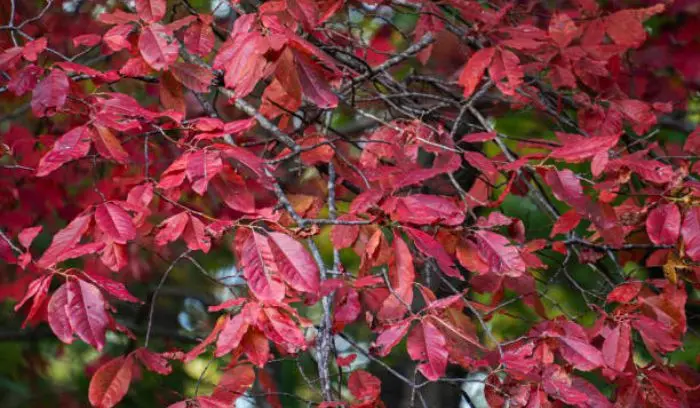
The Sourwood tree, also known as Oxydendrum arboreum, is a native species that thrives in the woodland areas of the southeastern United States. It’s a tree that can really make a statement in any landscape, especially during autumn when its foliage turns from green to vibrant shades of scarlet, deep pink, and purple.
As a small to medium-sized tree, it typically grows to a height of about 20-30 feet, which makes it perfect for planting as an understory species in woodlands. The plant prefers partial shade and acidic soil, making these conditions its ideal environment for growth.
During summer, the stalks of the Sourwood tree bloom with white, bell-shaped flowers that provide a lovely contrast against its lush green leaves.
The striking glowing foliage it produces adds a unique touch to any garden or natural area. If you’re looking to add a beautiful, low-maintenance tree that offers both beauty and ecological benefits, the Sourwood might be just what you need.
10. Cockspur Hawthorn (Crataegus crus-galli)

The Cockspur Hawthorn is a small, flowering tree that shines in spring with its abundant white blooms. After blooming, it produces persistent red berries, adding an attractive touch to your garden.
As the year progresses, the oval-shaped canopy transforms, displaying beautiful hues of pink, purple, and vibrant neon red in fall. The glossy green leaves gradually change color, creating a stunning display. This tree grows to a height of about 20-30 feet tall and wide, making it perfect for small yards or urban landscapes.
Planting it in full sun or partial shade with well-drained soil is ideal. If you’re looking for a tree that pairs well with ornamental cherries, crabapples, or smaller maple species, the Cockspur Hawthorn is a great choice for creating a colorful display in your autumn landscape.
It’s a wonderful addition to any garden, and with its pink-leaved trees, it can serve as a focal point, adding unconventional beauty to the surrounding area. Make sure to consult local nurseries to find the best variety for your growing zone.
FAQs
In the fall season, trees like maples, burning bush, and dogwood turn pink, red, and purple due to the pigment anthocyanin. Its production varies each year based on environmental factors, creating beautiful coloration in the foliage. Trees such as Bigtooth maple and flowering pear are known for this striking color change.
The pink leaves show how certain species adapt to the cooler weather, making the fall season visually captivating.
The Tricolor Beech is a beech tree with pink leaves, featuring pale pink, purplish green, and rose margins in its foliage. This cold hardy tree grows in zone 4, tolerates urban conditions, and thrives in partial sun and wetter conditions.
Its striking variegation and wide canopy add beauty to any landscape, especially in cooler climates.
Trees like maples, sweetgum, oaks, dogwoods, and sassafras trees have vibrant red leaves in the fall due to a pigment called anthocyanin. Other trees such as black tupelo trees, sourwood trees, and persimmons also display this striking color during autumn.
The Black Tupelo (Nyssa sylvatica) is a tree known for its purple leaves in autumn that later fade to a deep scarlet. This tree can grow up to 75 feet tall and is mostly left alone by pests. However, animals like deer and birds, such as the American robin, enjoy eating its fruit and leaves.
The Cercis canadensis, or Eastern Redbud, is known for its pink leaves that start off heart-like and gradually turn deep green as the tree grows older. This tree adds vibrant color to gardens, thriving in both sunny and partially shaded areas.
For a pop of color in your yard during fall and winter, consider the Weigela. Known for its ladylike flowers and classic pink blooms, this tree brightens your garden through multiple seasons. Some varieties of pink flowering trees even keep your yard lively as the year progresses.
The mimosa tree, or Persian silk tree, is a great choice for pink blooms. Its unique flowers feature long pink strands that resemble a paintbrush. The distinctive shape and structure of these blooms make it stand out in any garden.
This tree adds a vibrant touch with its delicate pink flowers, perfect for adding color to your yard.
Pink flowering trees are visually stunning plants that can bring bold or delicate beauty to any garden. The Persian silk tree and weeping cherry are two examples, offering showy and romantic blooms. These trees come in various varieties, making them suitable for different grow zones and maintenance requirements, perfect for any gardener.
Conclusion,
Trees with pink leaves or pink flowers offer a unique and vibrant addition to any garden or landscape. Whether it’s the delicate shades of the Pink Flair Cherry, the bold Persian silk tree, or the striking foliage of trees like the Red Maple and Trident Maple, these trees can create a stunning visual effect during the fall season. Their ability to provide year-round beauty, from spring blooms to autumn color, makes them perfect for enhancing the charm and appeal of your outdoor space.
SEE ALSO:
A Brief Guide To Japanese Trees
14 Trees That Keep Their Leaves All Year Round

